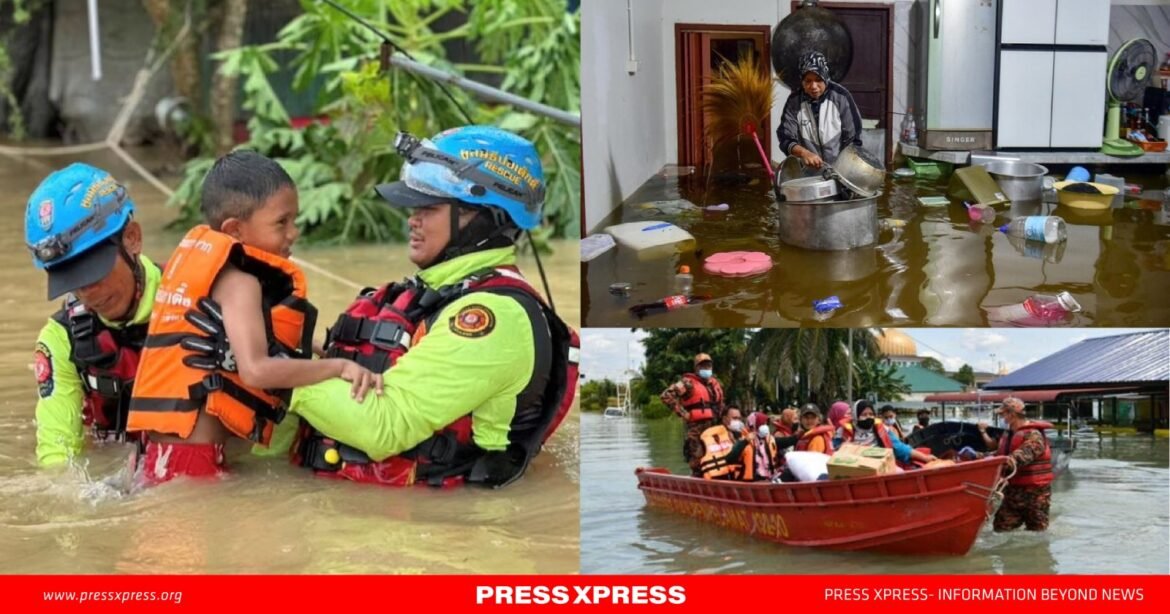…the flooding in Malaysia and Thailand highlights the growing vulnerability of Southeast Asia to extreme weather events, many of which are exacerbated by climate change
Heavy flooding in Malaysia and Thailand has triggered widespread devastation, with at least 12 confirmed deaths and over 135,000 people displaced as of the latest reports. The flooding, caused by torrential rains, began earlier in the week, and as emergency services race to assist affected residents, there are growing fears that the toll could rise in the coming days. Both countries, familiar with monsoon season disruptions, are bracing for continued downpours, with authorities scrambling to provide relief amid the chaos.
The Immediate Impact
As of now, Malaysia has seen the brunt of the flooding, with the northeastern state of Kelantan, bordering Thailand, experiencing the worst conditions. More than 122,000 people have been forced to evacuate their homes, and this number could continue to climb as heavy rain persists. In Thailand, around 13,000 individuals have been displaced, though the broader impact is more widespread. Flooding has affected nearly 534,000 households in southern Thailand, prompting the closure of two hospitals to protect medical facilities from the rising waters.
Local officials are struggling to cope with the magnitude of the disaster. In Kelantan, about 63% of Malaysia’s total evacuees have come from this state alone. The Malaysian National Disaster Management Agency (NADMA) reported that entire neighborhoods are submerged, with roads impassable, leaving many stranded without supplies. Some regions, such as Pasir Puteh, are seeing floodwaters reach as high as two inches from entering homes, further heightening fears of worsening conditions.
Government Response and Relief Efforts
In Thailand, the government has already designated 50 million baht (roughly $1.7 million) in relief funds for each of the six affected provinces. Prime Minister Paetongtarn Shinawatra has emphasized the urgency of restoring normalcy, saying the goal is to “restore normalcy as quickly as possible.” Authorities have deployed rescue teams, with dramatic footage circulating online of rescuers pulling a baby from the roof of a flooded house in Sateng Nok district.


Similarly, Malaysia’s government has vowed to take immediate action, dispatching supplies and disaster management resources to the worst-hit states of Terengganu and Kelantan. Prime Minister Anwar Ibrahim has suspended all cabinet members’ leave to ensure that government focus remains on disaster relief efforts. The Malaysian Meteorological Department has warned that rain is expected to continue through the weekend, compounding the difficulties faced by emergency teams.
Historical Context and Growing Concern
This flooding disaster is particularly concerning for both nations, given that flooding is not an uncommon occurrence during the monsoon season. However, experts suggest that the intensity of the rains this year could be linked to changing climate patterns. In Malaysia, the 2014 floods—among the worst in the country’s history—saw more than 100,000 people displaced. This year, the number of displaced people has already surpassed that record, raising concerns that the country’s infrastructure may not be able to handle such extreme events in the future.

Heavy rain could continue in both countries over the next couple of days. Credit: AFP
Thailand has experienced similar devastation before. In 2011, widespread flooding across the country killed at least 500 people and left millions homeless. The country’s flood mitigation measures have been in place for years, but the scale of the recent disaster has exposed gaps in preparedness and resilience.
The Socioeconomic Costs
The economic toll of these floods is already becoming apparent. In Malaysia, widespread damage to infrastructure, agriculture, and homes is expected to run into the billions of dollars. Local businesses and farmers are particularly vulnerable, with many unable to resume operations in the flooded regions. Meanwhile, in Thailand, the floods have wreaked havoc on both residential and commercial properties, affecting supply chains and trade in the region.
Beyond the immediate financial damage, the human cost of these disasters is profound. Thousands of families have been displaced, many forced to seek refuge in temporary shelters, where conditions are often overcrowded and insufficient to meet basic needs. Local authorities are working tirelessly to distribute food, clean water, and medical supplies, but the logistics of relief are complicated by ongoing rain and the widespread damage to infrastructure.
Lastly, the flooding in Malaysia and Thailand highlights the growing vulnerability of Southeast Asia to extreme weather events, many of which are exacerbated by climate change. Both countries face the dual challenge of responding to immediate disaster relief needs while also addressing long-term resilience strategies. As global temperatures continue to rise, the region must invest in better flood defenses, improved urban planning, and more effective disaster management systems to mitigate the impact of future crises.


